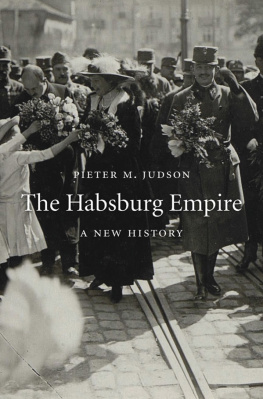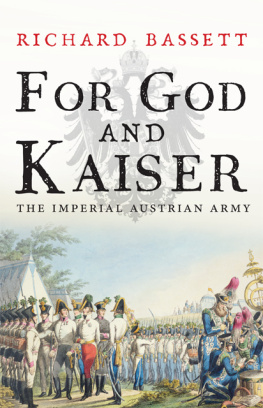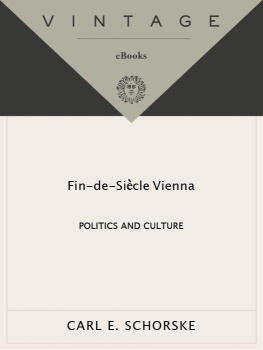AUSTRIAN CULTURE
Margarete Lamb-Faffelberger
General Editor
Vol. 48
______________________
This book is a volume in a Peter Lang monograph series.
Every volume is peer reviewed and meets
the highest quality standards for content and production.
______________________

Katherine Arens
Belle Necropolis
GHOSTS OF IMPERIAL VIENNA

Library of Congress Cataloging-in-Publication Data
Arens, Katherine.
Belle necropolis: ghosts of imperial Vienna / Katherine Arens.
pages cm. (Austrian culture; volume 48)
Includes bibliographical references and index.
1. Vienna (Austria)Civilization. 2. Vienna (Austria)Intellectual life.
3. Vienna (Austria)Social life and customs. 4. AustriaIntellectual life19th century.
5. Nationalism and collective memoryAustria. I. Title.
DB851.A74 943.603dc23 2014025271
ISBN 978-1-4331-1900-2 (hardcover)
ISBN 978-1-4539-1427-4 (e-book)
ISSN 1054-058X
Bibliographic information published by Die Deutsche Nationalbibliothek.
Die Deutsche Nationalbibliothek lists this publication in the Deutsche
Nationalbibliografie; detailed bibliographic data are available
on the Internet at http://dnb.d-nb.de/.
2015 Peter Lang Publishing, Inc., New York
29 Broadway, 18th floor, New York, NY 10006
www.peterlang.com
All rights reserved.
Reprint or reproduction, even partially, in all forms such as microfilm,
xerography, microfiche, microcard, and offset strictly prohibited.
Katherine Arens received her Ph.D. from the Departments of German Studies and Humanities at Stanford University. Currently she is a professor in the Department of Germanic Studies at the University of Texas at Austin. Dr. Arens served as past president of the Austrian Studies Association and member of the European Academy of Sciences and Arts and has written widely on Austrian and German intellectual and cultural history and minority discourses.
Since coming to public notice through major museum catalogues and the work of Carl Schorske around 1980, fin de sicle Vienna has been cast as the final bloom of a dying culture. Yet this assessment is itself a historical construct, deriving from the politics of the twentieth century. This volume argues that Habsburg nostalgia is anything but backward looking: instead, images from this glittering Habsburg past become evidence of a cultures sophisticated sense of how and why history is made, in both official and popular spheres. Including the first translation of an original account of Crown Prince Rudolfs suicide at Mayerling in 1889, Belle Necropolis argues for Austrias continued reuse of its own history to point the way toward the future rather than simply memorializing a past that only exists as living memories of shared stories, not as a truth in itself. Case studies included here range from imperial stereotypes before 1900 through their adaptations in the film 1. April 2000 and todays musicals, and from the politics of representing Austria since Rebecca West up through Schorskes master narrative of the Ringstrasse. Through these studies, Habsburg culture emerges as a culture of commemoration that uses its own past to overcome the limits of a small country seeking a role on the contemporary world stage.
This edition of the eBook can be cited. To enable this we have marked the start and end of a page. In cases where a word straddles a page break, the marker is placed inside the word at exactly the same position as in the physical book. This means that occasionally a word might be bifurcated by this marker.
This book would not have been possible without the support of many, since it was begun and finished at the two ends of a difficult era.
First and foremost, I would like to acknowledge that the publication of this book was made possible by a University of Texas Subvention Grant, awarded by President William C. Powers, Jr. His support of this program in this age of austerity reflects his unwavering commitment to the faculty of The University in the face of adversity, and I know I speak for many who are grateful for his support and leadership.
Numerous colleagues have been generous discussants of parts of this work, helping me to see around some difficult corners. Special thanks to Robert von Dassanowsky, historian extraordinare of Austrian film, for his help on the back story of 1. April 2000, to David Luft for his wisdom on Musil and his general good counsel, and to Janet Swaffar, the colleague whose wisdom we all need, who suffered through many discussions about why Austria is not Germany.
Without the support of Janet Swaffar, Leah Ross, and Carlos Amador, the project would not have gotten off the ground; they made it possible for me to present the first version of the Schorske material at the conference of the Modern Austrian Literature and Culture Association (now the Austrian Studies Association) at the University of Vienna, and to keep my eyes on the finish linethe rare vii | viii combination of great souls and good readers. These three, along with Philip Russell, have at various times and repeatedly over the last four years, kept me from going off the rails that led me to the finish line. On another front, Pamela Myers remained a cheerful voice who supported me unwaveringly where I could not put my hand in. They are the family we all wish we had, and I want to thank them all profusely, as well as the other friends whove stepped in with great good cheer.
William Russell has stood by me through thick and thin, both on my side and on his, never wavering in his belief in and support for me and these ghosts from the other side of the world. This volume is dedicated to himit should be much more.
Austria, successor state to a Holy Roman, then Austrian, then Austro-Hungarian Empire that never had an official name, is remembered today principally for its marketing. The popular mind settled on fin de sicle Vienna as the image of an imperial power that was disassembled at the end of the First World War. But it has always had an allure, a myth surrounding it.
At least since the 1970s, complaints have been raised against Vienna as the heart of Austrias museale Kultura fossil, museum (even mausoleum) city, rather than an environment fostering innovation. This image was reinforced by the plethora of Vienna 1900 museum exhibits of the late 1970s and early 1980s, and by Schorskes discussion of theRingstrasse in Fin de sicle Vienna (1981). To this day, these charges have stuck, no matter that, in the 1970s, Austrias young intellectuals and artists actually were actively working against these stereotypes, taking aim at what they considered the excess state funding directed at the Vienna Opera and the Salzburg Festival by an increasingly conservative Austrian Peoples Party (VP) administration. Nonetheless, Vienna persists in the musty, funereal image established in the public mind by the Third Man s tour through its sewers and perpetuated on webpages calling it die Nekropole, the necropolis.









